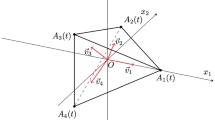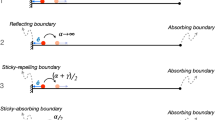Abstract
The reaction processA + B → ∅ is modeled for ballistic reactants on an infinite line with particle velocitiesυ A =c andυ B = -c and initially segregated conditions, i.e., allA particles to the left and allB particles to the right of the origin. Previous models of ballistic annihilation have particles that always react on contact, i.e., pair-reaction probabilityp = 1. The evolutions of such systems are wholly determined by the initial distributions of particles and therefore do not have a stochastic dynamics. However, in this paper the generalization is made to p< 1, allowing particles to pass through each other without necessarily reacting. In this way, theA andB particle domains overlap to form a fluctuating, finitesized reaction zone where the product ∅ is created. Fluctuations are also included in the currents ofA andB particles entering the overlap region, thereby inducing a stochastic motion of the reaction zone as a whole. These two types of fluctuations, in the reactions and particle currents, are characterised by theintrinsic reaction rate, seen in a single system, and theextrinsic reaction rate, seen in an average over many systems. The intrinsic and extrinsic behaviors are examined and compared to the case of isotropically diffusing reactants
Similar content being viewed by others
References
For a recent review see S. Redner inNonequilibrium Statistical Mechanics in One Dimension, ed V. Privman, Cambridge University Press, 1997.
R. Kroon, H. Fleurent, and R. Sprik,Phys. Rev. E 47:2462 (1993).
D. Toussaint and F. Wilczek,J. Chem. Phys. 78:2642 (1983).
Part VII-Experimental results.Nonequilibrium Statistical Mechanics in One Dimension, ed V. Privman, Cambridge University Press, 1997.
L. Gálfi and Z. Râcz,Phys. Rev. A 38:3151 (1988).
Y. Elskens and H. L. Frisch,Phys. Rev. A 31:3812 (1985).
M. Droz, P. A. Rey, L. Frachebourg, and J. Piasecki,Phys. Rev. E 51:5541 (1995).
J. Piasecki,Phys. Rev. E 51:5535 (1995).
J. Piasecki, P. A. Rey, and M. Droz,Physica 229A:515 (1996).
P.-A. Rey, M. Droz, and J. Piasecki,Euro. Jour. Phys. (may 1997, to appear).
E. Ben-Nairn and S. Redner,J. Phys. A 25:L575 (1992).
G. T. Barkema, M. J. Howard, and J. L. Cardy,Phys. Rev. E 53:R2017 (1996).
M. Bramson and J. L. Lebowitz,J. Stat. Phys. 65:941 (1991).
B. P. Lee and J. Cardy,Phys. Rev. E 50:R3287 (1994).
S. Cornell and M. Droz,Phys. Rev. Lett. 70:3824 (1993).
M. J. E. Richardson and M. R. Evans,J. Phys. A 30:811 (1997).
S. Cornell, M. Droz, and B. Chopard,Phys. Rev. A 44:4826 (1991).
M. Araujo, S. Havlin, H. Larralde, and H. E. Stanley,Phys. Rev. Lett. 68:1791 (1992).
P. L. Krapivsky,Phys. Rev. E 51:4774 (1995).
S. Cornell,Phys. Rev. E 51:4055 (1995).
S. A. Janowsky,Phys. Rev. E 51:1858 (1995).
I. Ispolatov, P. L. Krapivsky, and S. Redner,Phys. Rev. E 52:2540 (1995).
A. Turing,Philos. Trans. Roy. Soc. London Series B 237 :37.
S. Sandow and G. Schütz,Europhys. Lett. 26:7 (1994).
S. Sandow,Phys. Rev. E 40:2660 (1994).
F. H. L. Essler and V. Rittenberg,J. Phys. A 29:3375 (1996).
B. Derrida, M. R. Evans, V. Hakim, and V. Pasquier,J. Phys A 26:1493 (1993).
L. C. Biedenharn,J. Phys. A 22:L873 (1989).
G. Schütz and E. Domany,J. Stat. Phys. 72:277 (1993).
Author information
Authors and Affiliations
Corresponding author
Rights and permissions
About this article
Cite this article
Richardson, M.J.E. Exact solution of two-species ballistic annihilation with general pair-reaction probability. J Stat Phys 89, 777–799 (1997). https://doi.org/10.1007/BF02765544
Received:
Issue Date:
DOI: https://doi.org/10.1007/BF02765544




